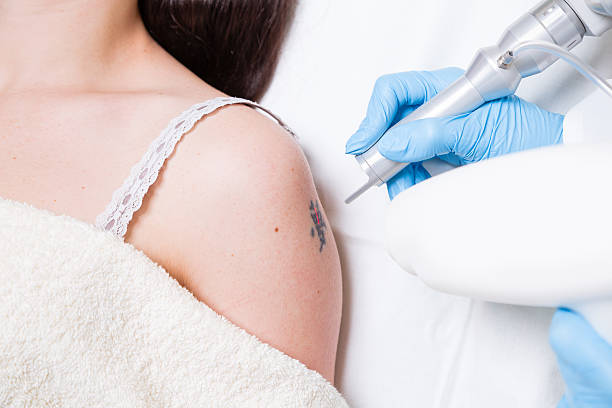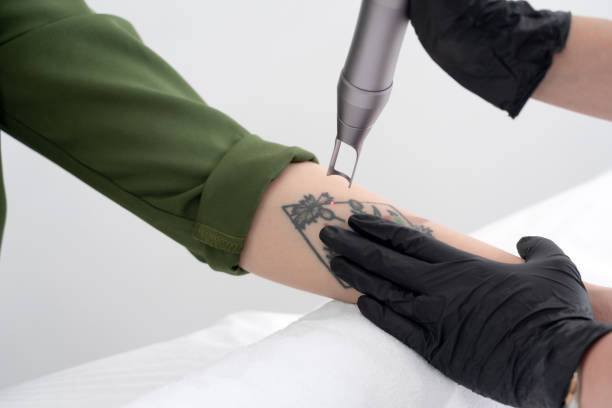Can a Tattoo Be 100% Removed? The Complete Guide to Tattoo Removal
2025-04-10
Discover the truth about tattoo removal with CIELLULU's comprehensive guide. Explore whether a tattoo can be 100% removed, diving into the most effective techniques and factors that influence results. Our expert insights and innovative solutions ensure you get informed and confident in your journey to a fresh start. Explore Can a Tattoo Be 100% Removed? today.
Introduction
Tattoos are often seen as permanent marks of self-expression, but many individuals who have tattoos may eventually regret their decision. Whether due to a change in personal taste or a desire for a fresh start, the question often arises: Can a tattoo be completely removed? In this guide, we will explore the science behind tattoo removal, the effectiveness of various methods, and what you can expect during the process.
Tattoo removal has evolved considerably over the years, with advanced technologies providing people with effective solutions to rid themselves of unwanted ink. However, while these methods have a high success rate, complete removal isn't always guaranteed, depending on several factors such as tattoo size, ink color, and skin type.
How Tattoo Removal Works
Tattoo removal works by targeting the ink in the skin with specific energy, which breaks the ink into smaller particles. The body then naturally removes these particles over time. Different removal techniques target the ink in distinct ways, but the ultimate goal is to fade the tattoo until it is no longer visible.
Laser tattoo removal is the most commonly used and effective method, utilizing concentrated light beams that penetrate the skin to break down the ink. The process involves several sessions, and the removal success depends on several factors, including ink color, depth, and the type of laser used.
Laser Tattoo Removal Process

Laser tattoo removal involves using high-intensity laser light to break up the ink particles in the tattoo. The light energy is absorbed by the pigment, causing it to break into tiny particles that the body’s immune system can remove. This technique is typically performed in several sessions spaced weeks apart.
Laser treatments vary based on the type of ink used and the tattoo's size. Some colors, like black, respond better to lasers, while others may require specialized lasers or multiple treatments. Although laser tattoo removal is generally considered safe, it can be uncomfortable, and proper aftercare is essential for achieving the best results.
Other Tattoo Removal Methods
While laser tattoo removal is the most common method, there are other techniques available. Surgical excision involves cutting the tattooed skin and stitching the area back together, which is suitable for smaller tattoos but leaves a scar. Dermabrasion is another option where the skin is "sanded" to remove the tattoo, but it is less common due to potential side effects. Chemical peels can also help fade tattoos, though they tend to be less effective than laser treatment.
Each method comes with its own set of pros and cons, so it’s essential to consult with a professional to determine the most suitable option for your situation.
Can a Tattoo Be Completely Removed?
The short answer is that it is possible, but not guaranteed. Laser tattoo removal is highly effective, but several factors can influence whether the tattoo will be 100% removed. Factors such as the tattoo’s age, the colors used, the depth of the ink, and your skin type all contribute to the likelihood of complete removal.
Some tattoos, particularly those with lighter colors or older ink, may require fewer sessions and may have a higher chance of complete removal. On the other hand, tattoos with bright colors or thick, deep layers of ink may be harder to remove entirely.
Factors Affecting Tattoo Removal Success

Several factors can affect how well a tattoo responds to removal treatments. The most important factors include:
Ink color: Darker inks like black and blue are easier to remove than lighter inks such as green and yellow.
Tattoo size: Larger tattoos may require more sessions and can be more challenging to remove completely.
Skin type: Individuals with lighter skin tones typically see better results, while darker skin may present more challenges, particularly with certain laser types.
Age of the tattoo: Older tattoos may have faded over time, making them easier to remove compared to newer tattoos.
Understanding these factors will help you set realistic expectations for the tattoo removal process.
Risks and Side Effects of Tattoo Removal
While tattoo removal is generally safe, it does come with some risks and potential side effects. These can include:
Scarring: Some individuals may develop scars after treatment, particularly if the tattoo is deep or the skin doesn’t heal properly.
Skin discoloration: Temporary or permanent changes in skin pigmentation can occur, particularly in individuals with darker skin tones.
Infection: If proper aftercare is not followed, there’s a risk of infection.
However, modern technologies, especially those used in laser tattoo removal, have minimized these risks significantly, and many individuals experience little to no side effects.
Conclusion
In conclusion, while it is possible to remove a tattoo completely, the results depend on various factors such as tattoo type, size, and skin type. Laser tattoo removal is the most effective and widely used method, but some tattoos may require multiple sessions or even a combination of treatments.
If you're considering tattoo removal, make sure to choose a trusted provider with experience in laser treatments. It’s also essential to follow all aftercare instructions to ensure the best possible results. For those looking for high-quality laser removal devices, CIELLULU offers advanced solutions tailored to individual needs. Visit CIELLULU’s website to explore their technology and learn more about how they can assist you in achieving clear, tattoo-free skin.
FAQs
Can a tattoo be 100% removed?
Yes, but results vary. Black ink is easiest, while multicolored tattoos may leave faint traces.
How many laser sessions are needed?
Typically 6-12 sessions, spaced 6-8 weeks apart.
Does tattoo removal hurt?
Yes, but numbing creams and cooling devices help.
Are there tattoos that can’t be removed?
Some colors (green, fluorescent) resist lasers. Professional consultation is needed.
What’s the best method for tattoo removal?
Laser removal (Q-switched or picosecond lasers) is the gold standard.
Can I remove a tattoo at home?
DIY methods (creams, acids) are unsafe and ineffective. Always consult a professional.
Tags
laser tatto removal machine in Malaysia
laser tatto removal machine in Malaysia
laser hair removal machines china
laser hair removal machines china
aesthetic lasers for sale
aesthetic lasers for sale
new laser hair removal machine
new laser hair removal machine
buy nd yag laser for sale Brazil
buy nd yag laser for sale Brazil
aesthetic lasers for sale
aesthetic lasers for sale
Menu
Recommended for you

CIELLULU: A Leading Diode Laser Hair Removal Manufacturer

How to treat melasma with laser?

K3 Hair Removal: A Pain-Free, Effective Solution with Diode Laser Technology

Understanding Types of Tattoo Removal Lasers | CIELLULU
Prdoucts Categories
You may also like

CIELLULU S500 1500W Diode Laser Hair Removal & Skin Rejuvenation Machine
Diode Laser Painless Hair Removal Machine is especially effective on hair follicle melanocytes without causing damage to the surrounding tissue.

CIELLULU MULA K2 BroadBand Light DPL beauty machine for skin care and hair removal
ACNE/Pigmentation/Vascular Lesions Treatment, Skin Rejuvenation and Hair Removal.

CIELLULU Q-Switched ND:YAG Laser LIFFAN Q6
Pigment Removal & Tattoo Removal & Skin Rejuvenation
Get in touch with us
If you have any comments or good suggestions, please leave us a message. Later, our professional staff will contact you as soon as possible.
Copyright © 2024 CIELLULU. | Privacy Policy • Terms and Conditions
















